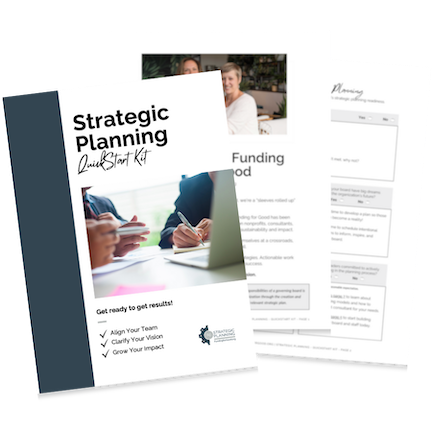Governance—or lack thereof—in the business world has been making headlines of late. So here at Funding for Good we thought we’d take a moment to explore some key governance questions in the nonprofit sector. What is nonprofit governance? Why does nonprofit governance matter? And how can board members and staff strengthen governance at their organizations?
What is Nonprofit Governance?
Let’s be honest. When we’re caught up in the day to day of running a nonprofit or business, governance can start to seem less like a vital function and more like an annoying task to check off a list. Schedule the board meeting. Send out the agenda. Finish the audit on time.
But as we’re seeing in the headlines, governance can make or break an organization. Recently, all eyes are on Twitter, Meta, and FTX, but those are only the latest examples of upheavals at organizations prioritizing charismatic leadership over strong and sustainable governance.
As Yale School of Management’s Jeffrey Sonnenfeld described to CNBC:
It’s not crazy to talk about Theranos, or WeWork, Groupon, MySpace, WebMD, or Naptster — so many companies that fall off the cliff because they didn’t have proper governance, they didn’t figure out, how do you get the best of a genius?
At for-profit and nonprofit organizations alike, governance matters.
Governance provides the type of consistent oversight, accountability, and checks and balances that can ensure nonprofit organizations both reach their goals and remain sustainable for the long-term. In nonprofits, this role is most often filled by the Board of Directors.
Nonprofit Board Governance Models
Most nonprofits rely on a board governance model. As we’ve shared before, in this model the board is responsible for:
- Establishing organizational direction
- Providing oversight of the organization, including managing the Executive Director; if there is no Executive Director, the board’s role may entail more hands-on management
- Ensuring resources required to fulfill the organization’s mission
With this level of responsibility, ensuring your Board of Directors is functioning at its best is critical.
Unfortunately, this isn’t always the case. It doesn’t help that recruiting board members can be difficult—much less recruiting great board members. Indeed, nonprofit board seats are generally non-paying positions that also come with annual giving expectations. There’s often a scramble to fill empty board seats, with prioritization given to those who are willing to show up for quarterly meetings or open their checkbooks once a year.
This approach to nonprofit board governance models can leave organizations vulnerable.
That’s why Funding for Good works with both nonprofit staff leadership and nonprofit board leadership to providing training and support.
Funding for Good: Board Solutions
Tips for Nonprofit Board Members
Board members can start strengthening nonprofit governance at their organization today by:
- Asking hard questions: Often, staff members prepare extensively before presenting at board meetings. Because agendas are usually packed, there may be limited time for deeper questions. Board members should be prepared to go beyond a polished presentation and ask tough questions. That could include asking for materials in advance, asking to create more space in the agenda, or setting aside time for follow up conversations. Asking hard questions doesn’t have to be antagonistic. It’s a service that board members are providing, with the aim of fulfilling their governance roles.
- Understanding the data: Data tells a story. But that story can easily get lost in translation. Board committees in particular—such as the executive committee, finance committee, fundraising committee and governance committee—should be receiving extensive and detailed materials to review. This could include annual budgets, quarterly budget-to-actuals, annual audits and tax filings, as well as narrative reports on programmatic work and internal operations. This level of information can be overwhelming, but it’s worth taking the time to sit down and carefully review the data and understand the story it’s telling about the sustainability of the organization.
- Strengthening executive leadership: One key role for the board is hiring, managing, and evaluating the Executive Director. Hiring alone can be incredibly challenging. In filling an Executive Director position, the board is looking for management skills, program area knowledge and experience, and leadership style. No matter how skilled the candidate, a mismatch in leadership style can undermine even the healthiest organization. Once an Executive Director is onboarded, we recommend the board align on concrete metrics for evaluation. This should go beyond simply raising money to consider whether the Executive Director is creating a productive and inclusive work culture.
Luckily, there’s a tool that can help board members accomplish all of these nonprofit governance activities: a strategic plan.
Nonprofit Governance: Better with a Strategic Plan
One of the most powerful governance tools for both board and staff leadership is a strong strategic plan. A strategic plan is created in partnership with both board and staff, a process designed to build consensus and transparency across leadership and governance roles.
During a strategic planning process, board members will get fresh, unfiltered insights into how their organization works and what internal challenges may be brewing. The end result also gives both board and staff clear metrics to evaluate success. Ideally, boards will review their strategic plan at least twice per year, assessing where things are working and where they aren’t.
Used this way, a strategic plan can be a powerful tool to keep an organization strong, well-functioning, and on-track to achieve its goals.
Are you looking for tools to strengthen your nonprofit governance? Check out our training series: Leading with Intent. It covers Building an A-List Board, Executive Committees in Action, Balancing Power between the ED and Board Chair, and much more.



